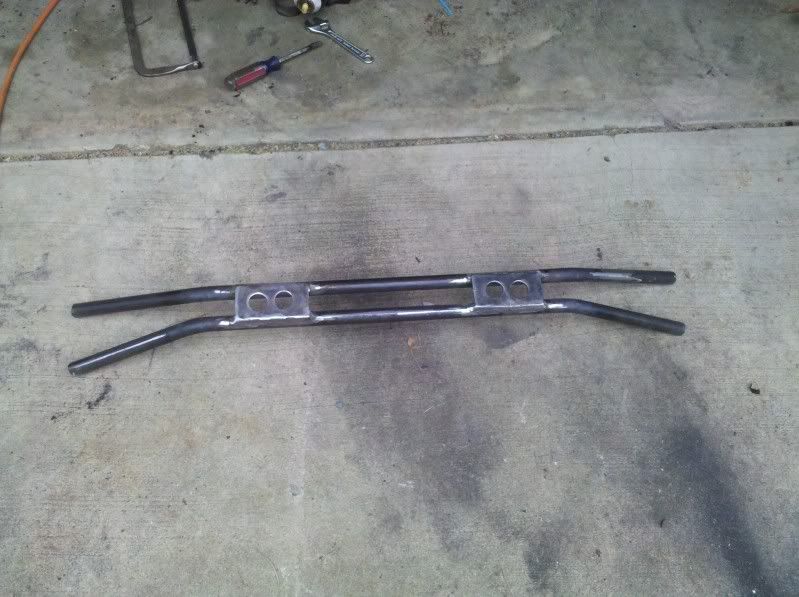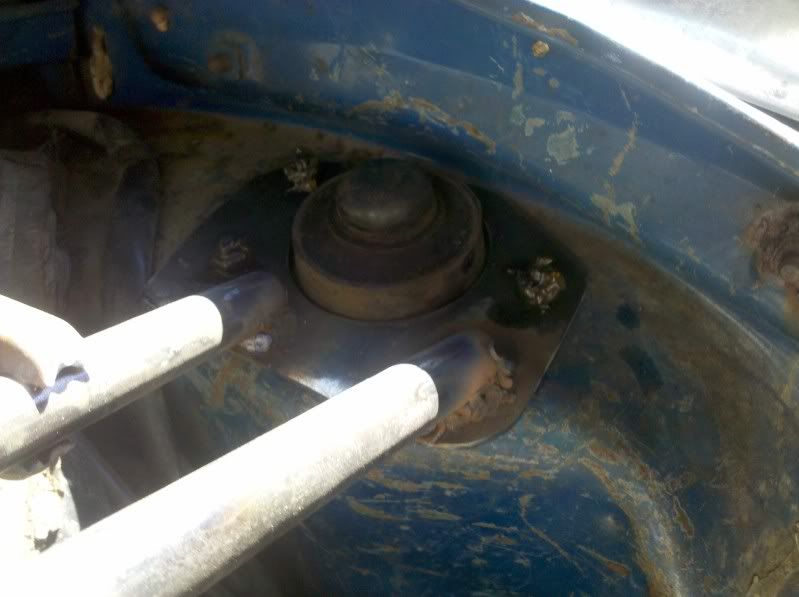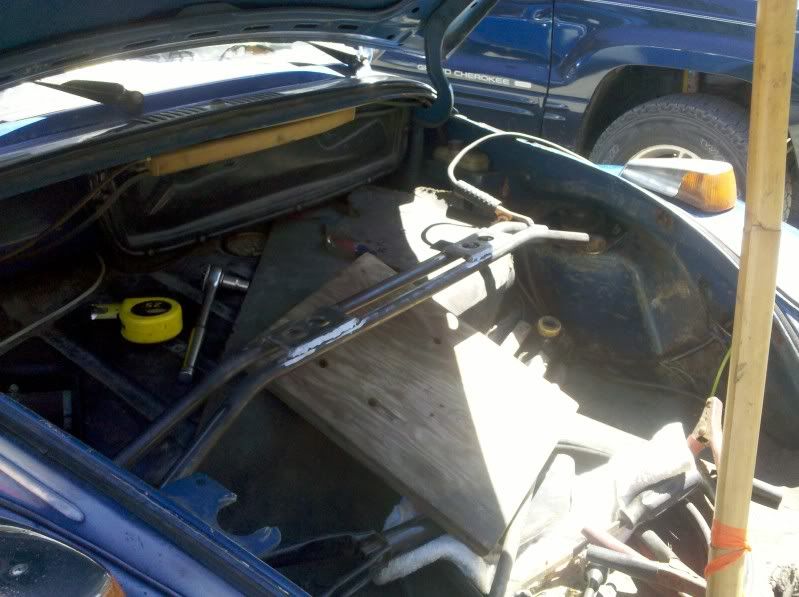I wanted to be sure that when I build this vehicle, I build it efficiently. Not just with time constraints, but with a tight budget. The body work is the most time consuming part for me. I have no experience in body work with the exception of sheet metal work and welding. I know how to do them, but have never done it on a car. I have no idea how to do body work except that you don't want a lot of filler. Filler is both your friend and your foe.
The idea of a Baja has always caught my eye. My brother had a VW Beetle when we were in high school and I saw the Baja kit in JC Whitney catalogs. I have already done part of the baja, but it was time for me to just get the whole care done. I purchased a parts car a while ago. I paid $150 for it and I got over $300 worth of parts not including the parts needed for the Baja. Well the parts weren't all that was thought. They were for a standard Beetle and I have a Super Beetle. Not the same parts. I guess I have to learn how to do fiberglass. More books to read. More research and more fun.
The old paint on parts of the car had to come off. There were 4 coats of paint on this door. That was too thick. Other parts were only 1 or 2 coats. Those parts just get sanding and finishing. The car needs to be done soon. I have other cars to get done. I am working every spare minute I have. The roof is dented and scratched bad. The curves on the roof make it difficult to get the filler right. You have to be sure that the contours match in multiple directions. More to come soon.
Building custom street and off-road vehicles. Currently building 1973 VW Super Beetle Baja.
Building Custom Street and Off-Road Vehicles
Sunday, April 24, 2011
Monday, April 4, 2011
Super Beetle front disc brake conversion
Everyone knows that the technology of brakes has improved tremendously since 1973 when this car was originally built. I had some issues with the brakes and actually being able to stop. The brakes would have to be pumped in order to be able to stop. The could be adjusted and adjusted and would not solve the problem. The braking force is mainly in the front brakes. With weight transfers, the front brakes do 80% of the braking depending on weight distribution. Back to the internet. I don't have any pics of this. I guess I should have done it. I purchased the Empi front brake conversion kit and figured that I should replace the master cylinder at the same time since the brakes had to be bled anyway. The rear brakes may be upgraded later. The Empi kit didn't come with any instructions on installation. The one thing to make sure of is that the caliper is centered on the rotor. This was accomplished with the provided washers that I initially couldn't figure out where they went.
Time for the test drive. I didn't have to drive any further than down the driveway and I almost put myself through the windshield. I guess they worked. It is probably one of the most important upgrade that was done. The rear brakes may be done over the summer. That depends on how much money I have after vacation.
Time for the test drive. I didn't have to drive any further than down the driveway and I almost put myself through the windshield. I guess they worked. It is probably one of the most important upgrade that was done. The rear brakes may be done over the summer. That depends on how much money I have after vacation.
Friday, April 1, 2011
Suspension
I was driving with my daughter and felt a nasty wobble of death. The front end shimmy that plagues the early Super Beetles got to mine. I had already changed the bushings in the front end so I took a good look at the front suspension. I pushed down on the front and it didn't come back up into place. Time for front struts. I searched on the internet and found out that the early 1973 and later 1973 have different front struts. There was an upgrade mid year. Since mine was an early 73, I had the older suspension and not the upgrade. I ordered struts and took out the strut towers. My local shop replaced the struts into the towers for a lot less than having them do the whole job. He charged me $40.00. Since I have another vehicle I can drive, I wasn't worried about it taking a few days for him to get to them. When I installed the towers, the car handled great. No more wobble. Now for the upgrade build on the front.
The forces of the yaw on the front suspension are transmitted into the body and actually twists the front end of the vehicle when in a turn. In order to transfer the energy to the other wheel and direct the forces to the inside wheel to increase gripping surface and weight distribution in the front, you need a bar that transfers the force. This bar is called a strut support bar. This force transfer assists in cornering. It makes the inside front wheel have more weight on it and makes for a more stable turn. This does not take the place of the sway bar. It makes it work more efficiently. I priced them on the internet and they were out of the range that I wanted to spend. Time to go shopping. I went to the store and got some pipe. Since I didn't have a tubing bender that will bend small tube, I went with the pipe. The amount of force generated is not too much for the pipe. I knew what I wanted the end product to look like, so I just had to make it. I bent the pipe with a torch and a vice, making sure that the bends were straight. I bent the first pipe and then placed it on the garage floor and traced it with a marker on the floor. When that was done, I had fun making the second. It took a lot of measuring to get the second pipe correct.
Now that I had the shape, I had to make a cardboard template for the tops of the strut towers. I used 1/8" plate for the tower plates and then welded it in place. I remembered to put grease on the bolts so that no weld splatter got stuck on the bolts.
Some grinding and some body filler and then paint and it was done.
I didn't take a pic of it painted.
The forces of the yaw on the front suspension are transmitted into the body and actually twists the front end of the vehicle when in a turn. In order to transfer the energy to the other wheel and direct the forces to the inside wheel to increase gripping surface and weight distribution in the front, you need a bar that transfers the force. This bar is called a strut support bar. This force transfer assists in cornering. It makes the inside front wheel have more weight on it and makes for a more stable turn. This does not take the place of the sway bar. It makes it work more efficiently. I priced them on the internet and they were out of the range that I wanted to spend. Time to go shopping. I went to the store and got some pipe. Since I didn't have a tubing bender that will bend small tube, I went with the pipe. The amount of force generated is not too much for the pipe. I knew what I wanted the end product to look like, so I just had to make it. I bent the pipe with a torch and a vice, making sure that the bends were straight. I bent the first pipe and then placed it on the garage floor and traced it with a marker on the floor. When that was done, I had fun making the second. It took a lot of measuring to get the second pipe correct.
Now that I had the shape, I had to make a cardboard template for the tops of the strut towers. I used 1/8" plate for the tower plates and then welded it in place. I remembered to put grease on the bolts so that no weld splatter got stuck on the bolts.
Some grinding and some body filler and then paint and it was done.
I didn't take a pic of it painted.
Subscribe to:
Posts (Atom)



